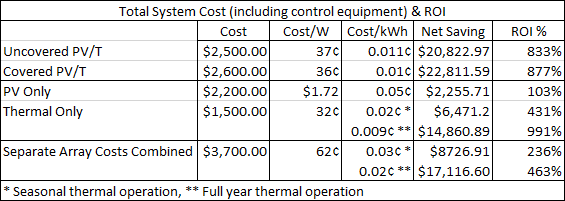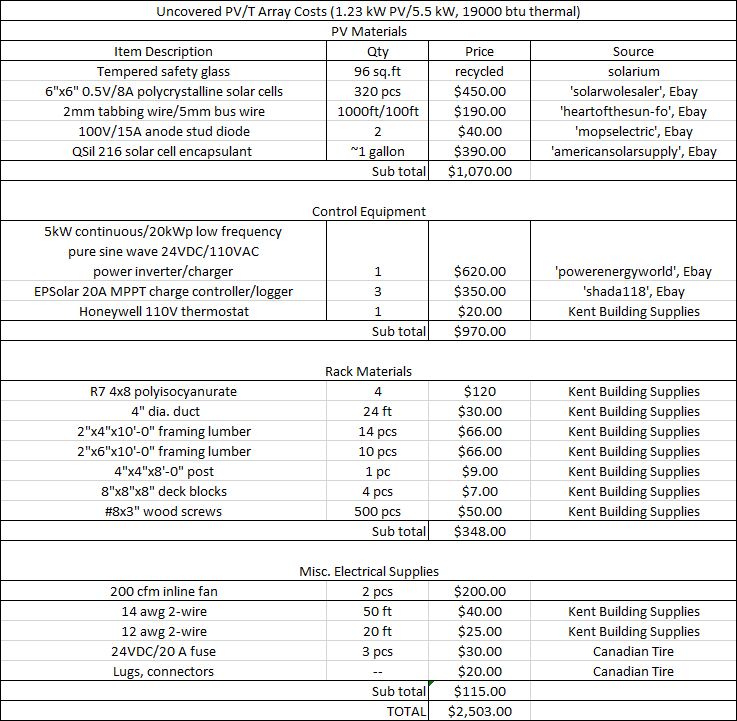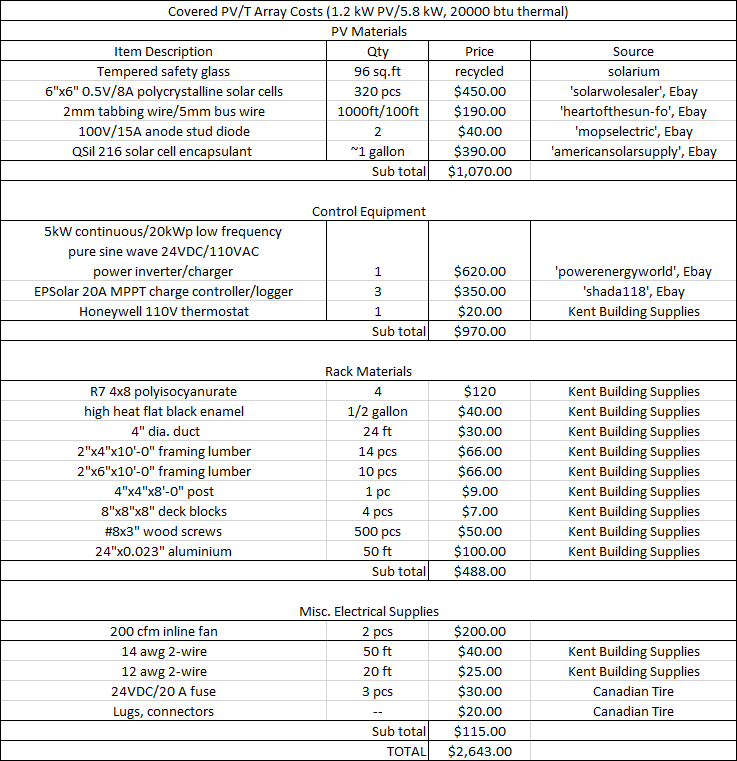Solar HVAC 3: Testing PV/T Solar Configurations
|
|
Share this page with your friends:
|
The testing and information presented below was done to approximate and compare the performance efficiency of various PV/T configurations for use in a small co-generative solar PV/T HVAC system.
Introduction/Hypothesis:
The time has come to decide what sort of PV/thermal configuration will be used for the HVAC system. If this is your first time here, I recommend checking out the previously published research below:
Desiccant Rotor Testing: Molecular Sieve
Combining Desiccant Dehumidification W/ Evaporative Cooling
The purpose of combining solar PV and thermal power technologies into one system is to take advantage of the heat produced by the PV cells, which reduces the collector surface area required to accomplish the same potential with two separate systems, and in turn reduces the amount of materials needed for construction and labour costs for installation. For example, instead of needing two mounting racks for separate PV and thermal systems, only one rack is required for a cogenerative system.
There are a two main types of PV/T configurations that can be utilised: uncovered and covered. An uncovered PV/T system has the PV cells encapsulated directly on the surface of the collector lens and a fluid is passed behind them to collect the heat they generate. In a covered PV/T system, the collector is separated from the lens via an air gap, vacuum sealed thermal pane, or an insulating gas. Because the collector isn't in direct contact with the lens in a covered system, there is less heat loss through the lens to the outside environment when compared to an uncovered system. However, the extra heat produced in the covered system will have a negative effect on the PV performance and decrease the cells' efficiency slightly. In shrt, a covered system produces a higher grade heat but less electrical power, and an uncovered system produces more electrical power but less heat. To help establish a cost benefit analysis and determine the most economical configuration, I constructed a couple of small PV/T panels to test and compare their performance potential.
The time has come to decide what sort of PV/thermal configuration will be used for the HVAC system. If this is your first time here, I recommend checking out the previously published research below:
Desiccant Rotor Testing: Molecular Sieve
Combining Desiccant Dehumidification W/ Evaporative Cooling
The purpose of combining solar PV and thermal power technologies into one system is to take advantage of the heat produced by the PV cells, which reduces the collector surface area required to accomplish the same potential with two separate systems, and in turn reduces the amount of materials needed for construction and labour costs for installation. For example, instead of needing two mounting racks for separate PV and thermal systems, only one rack is required for a cogenerative system.
There are a two main types of PV/T configurations that can be utilised: uncovered and covered. An uncovered PV/T system has the PV cells encapsulated directly on the surface of the collector lens and a fluid is passed behind them to collect the heat they generate. In a covered PV/T system, the collector is separated from the lens via an air gap, vacuum sealed thermal pane, or an insulating gas. Because the collector isn't in direct contact with the lens in a covered system, there is less heat loss through the lens to the outside environment when compared to an uncovered system. However, the extra heat produced in the covered system will have a negative effect on the PV performance and decrease the cells' efficiency slightly. In shrt, a covered system produces a higher grade heat but less electrical power, and an uncovered system produces more electrical power but less heat. To help establish a cost benefit analysis and determine the most economical configuration, I constructed a couple of small PV/T panels to test and compare their performance potential.
|
Methods:
Four panels were constructed from 1" thick aluminium foil backed polyisocyanurate: a PV only panel, a thermal only panel, a covered PV/T panel and an uncovered PV/T panel. With exception to the PV only panel, each panel measured exactly 12" wide, 30" high, and 2" deep which allowed a 1" gap for air flow through the collectors. The PV panel measured 12" x 30" and the glass for all panels was 1/8" thick low iron. All panels except for the thermal only panel contained four 0.5V/8A 3-tabbed monocrystalline solar cells connected in series with the positive and negative leads exiting the top of the panels. In the uncovered PV/T panel, the cells were mounted directly to the lens, and the back absorber was painted flat black. In the covered panel, the cells were mounted to a 0.023" thick aluminium heat sink that was formed to produce a 6.5" x 3/4" channel vertically through the collector while leaving a 1/4" air gap between the lens and the cells. The back absorber in the thermal only panel was simply painted flat black. 15 cfm axial fans were used to circulate air through all panels except for the PV only panel. Temperature data was collected via NTC sensors and PC software. Electrical power output measurements were taken with a multi-meter and documented on video. |
|
|
Results:
Each panel performed almost as anticipated. The PV only panel had the highest electrical efficiency with the uncovered panel just a few tenths of a percentage behind, while the covered PV/T panel had the lowest electrical efficiency. However, the covered PV/T panel had the highest thermal efficiency, while (oddly) the thermal only panel had the lowest thermal efficiency. Temperature data from this test can be viewed below, as well as a detailed bill of materials and cost benefit analysis comparison between uncovered and covered PV/T systems. It's close, but the numbers suggest that a covered PV/T system would be the most economical choice, yielding a net return in energy cost savings of over 870% (bare in mind that the calculated costs presented below do NOT include labour as I will be building and installing for myself; installation costs for solar power systems can be substantial compared to the cost of the actual technology. Wholesale prices for PV modules, for example, have been quite low/affordable and idle for some time now, while the decreasing overall system cost trend is largely attributed to decreasing labour and soft installation costs.) |
|
Potential Energy Cost Savings For 96 sq.ft Array
Collector area: 96 sq.ft
Avg total solar irradiance: 92 w, 317 btu/ sq.ft
Avg sunshine hours in Fredericton, NB: 3.5-4.5/d, ~1642/y
Expected system lifetime: 20 y
Avg total solar irradiance: 92 w, 317 btu/ sq.ft
Avg sunshine hours in Fredericton, NB: 3.5-4.5/d, ~1642/y
Expected system lifetime: 20 y
Total System Cost & Investment Return Comparison
Uncovered & Covered PV/T Bill Of Materials






